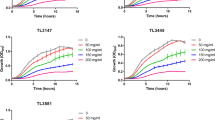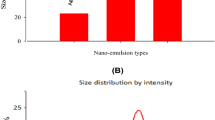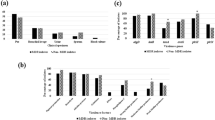Abstract
Pseudomonas aeruginosa is known for its metabolic versatility and uses a variety of substrates; interestingly, glucose is not the favored carbon source. Although glucose is not readily utilized by them, there is a possibility that the increased susceptibility of diabetics to infections with P. aeruginosa is related to the effect of glucose on the expression of virulence genes. The curiosity in understanding the effect of glucose on virulence gene expression in P. aeruginosa and the lacuna of studies in this field prompted us to undertake the current investigation. It included the quantification of various virulence factors and their gene expression upon supplementation with glucose in clinical MDR P. aeruginosa isolates recovered from diabetics. Interestingly, the study observed a remarkable difference in the virulence attributes in the isolates with and without glucose supplementation. External glucose was found to be modulating the QS gene expression, thus altering the elaboration of other virulence factors. Variations in the gene expressions induced by glucose partly explain the increased susceptibility of diabetic patients to P. aeruginosa infections.





Similar content being viewed by others
Data Availability
All relevant data are made available in the manuscript.
Code Availability
Not applicable.
References
Chen T, Xu Y, Xu W et al (2020) Hypertonic glucose inhibits growth and attenuates virulence factors of multidrug-resistant Pseudomonas aeruginosa. BMC Microbiol 20:1–10. https://doi.org/10.1186/s12866-020-01889-2
Grant SS, Hung TD (2013) Persistent bacterial infections, antibiotic tolerance, and the oxidative stress response. Virulence 4:273–283. https://doi.org/10.4161/viru.23987
Chai W, Wang Y, Jiao F, Wu Y, Wang S (2020) A severe diabetic foot ulcer with intermediate cuneiform displacement and multidrug-resistant Pseudomonas aeruginosa infection: a rare case report. Front Med 7:131. https://doi.org/10.3389/fmed.2020.00131
Suresh S, Alva PP, Premanath R (2021) Modulation of quorum sensing-associated virulence in bacteria: carbohydrate as a key factor. Arch Microbiol 203:1881–1890. https://doi.org/10.1007/s00203-021-02235-4
Moradali MF, Ghods S, Rehm BH (2017) Pseudomonas aeruginosa lifestyle: a paradigm for adaptation, survival, and persistence. Front Cell Infect 7:39. https://doi.org/10.3389/fcimb.2017.00039
Nelson RK, Poroyko V, Morowitz MJ, Liu D, Alverdy JC (2013) Effect of dietary monosaccharides on Pseudomonas aeruginosa virulence. Surg Infect 14:35–42. https://doi.org/10.1089/sur.2011.063
Raneri M, Pinatel E, Peano C, Rampioni G, Leoni L, Bianconi I et al (2018) Pseudomonas aeruginosa mutants defective in glucose uptake have pleiotropic phenotype and altered virulence in non-mammal infection models. Sci Rep 8:1–15. https://doi.org/10.1038/s41598-018-35087-y
She P, Wang Y, Liu Y, Tan F, Chen L, Luo Z, Wu Y (2019) Effects of exogenous glucose on Pseudomonas aeruginosa biofilm formation and antibiotic resistance. Microbiologyopen 8(12):e933. https://doi.org/10.1002/mbo3.933
Dolan SK, Kohlstedt M, Trigg S, Vallejo Ramirez P, Kaminski CF, Wittmann C, Welch M (2020) Contextual flexibility in Pseudomonas aeruginosa central carbon metabolism during growth in single carbon sources. MBio 11:e02684-e2719. https://doi.org/10.1128/mBio.02684-19
Garcia M, Pujol A, Ruzo A, Riu E, Ruberte J, Arbos A, Serafín A et al (2009) Phosphofructo-1-kinase deficiency leads to a severe cardiac and hematological disorder in addition to skeletal muscle glycogenosis. PLoS Genet 5:8. https://doi.org/10.1371/journal.pgen.1000615
Chaparro JM, Badri DV, Bakker MG, Sugiyama A, Manter DK, Vivanco JM (2013) Root exudation of phytochemicals in Arabidopsis follows specific patterns that are developmentally programmed and correlate with soil microbial functions. PLoS ONE 8:e55731. https://doi.org/10.1371/annotation/51142aed-2d94-4195-8a8a-9cb24b3c733b
Rojo F (2010) Carbon catabolite repression in Pseudomonas: optimizing metabolic versatility and interactions with the environment. FEMS Microbiol Rev. https://doi.org/10.1111/j.1574-6976.2010.00218.x
Ferrando M, van Baarle P, Orru G, Piga R, Bongers RS, Wels M et al (2014) Carbohydrate availability regulates virulence gene expression in Streptococcus suis. PLoS ONE 9:e89334. https://doi.org/10.1371/journal.pone.0089334
Suresh S, Prithvisagar KS, Kumar BK, Premanath R (2022) Unravelling the distinctive virulence traits and clonal relationship among the Pseudomonas aeruginosa isolates from diabetic patients. J Pure ApplMicrobiol 16:1893–1908. https://doi.org/10.22207/JPAM.16.3.37
Murray TS, Ledizet M, Kazmierczak BI (2010) Swarming motility, secretion of type 3 effectors and biofilm formation phenotypes exhibited within a large cohort of Pseudomonas aeruginosa clinical isolates. J Med Microbiol 59:511–520. https://doi.org/10.1099/jmm.0.017715-019
Essar DW, LE Eberly E, Hadero A, Crawford IP (1990) Identification and characterization of genes for a second anthranilate synthase in Pseudomonas aeruginosa: interchangeability of the two anthranilate synthases and evolutionary implications. J Bacteriol 172:884–900. https://doi.org/10.1128/jb.172.2.884-900.199020
Arora NK, Verma M (2017) Modified microplate method for rapid and efficient estimation of siderophore produced by bacteria. 3 Biotech 7:381. https://doi.org/10.1007/s13205-017-1008-y22
O’Toole GA, Kolter R (1998) Initiation of biofilm formation in Pseudomonas fluorescens WCS365 proceeds via multiple, convergent signalling pathways: a genetic analysis. Mol Microbiol 28:449–461. https://doi.org/10.1046/j.1365-2958.1998.00797.x23
Percival SL (2014) Wounds and infection. Biofilms in infection prevention and control. Elsevier, Amsterdam, pp 127–139. https://doi.org/10.1016/B978-0-12-397043-5.00008-624
Murachi T (1976) Bromelain enzymes. Methods Enzymol 45:475–485. https://doi.org/10.1016/S0076-6879(76)45042-5
Pearson JP, Pesci EC, Iglewski BH (1997) Roles of Pseudomonas aeruginosa Las and rhl quorum-sensing systems in control of elastase and rhamnolipid biosynthesis genes. J Bacteriol 179:5756–5767. https://doi.org/10.1128/jb.179.18.5756-5767.1997
Alva PP, Suresh S, Nanjappa DP, James JP, Kaverikana R, Chakraborty A, Sarojini BK, Premanath R (2021) Isolation and identification of quorum sensing antagonist from Cinnamomum verum leaves against Pseudomonas aeruginosa. Life Sci 267:118878. https://doi.org/10.1016/j.lfs.2020.118878
Dumas JL, Van Delden C, Perron K, Kohler T (2006) Analysis of antibiotic resistance gene expression in Pseudomonas aeruginosa by quantitative real-time-PCR. FEMS Microbiol Lett 254:217–225. https://doi.org/10.1111/j.1574-6968.2005.00008.x
Livak KJ, Schmittgen TD (2001) Analysis of relative gene expression data using real-time quantitative PCR and the 2− ΔΔCT method. Meth 25:402–408. https://doi.org/10.1006/meth.2001.1262
Corona F, Martínez JL, Nikel PI (2018) The global regulator Crc orchestrates the metabolic robustness underlying oxidative stress resistance in Pseudomonas aeruginosa. Environ Microbiol. https://doi.org/10.1111/1462-2920.14471
Daddaoua A, Molina-Santiago C, de la Torre J, Krell T, Ramos JL (2014) GtrS and GltR form a two-component system: the central role of 2-ketogluconate in the expression of exotoxin A and glucose catabolic enzymes in Pseudomonas aeruginosa. Nucleic Acids Res 42:7654–7663. https://doi.org/10.1093/nar/gku496
Armitage JP, Rowbury RJ, Smith DG (1976) The role of cyclic adenosine monophosphate in the swarming phenomenon of Proteus mirabilis. Experientia 32:1266–1267. https://doi.org/10.1007/bf01953085
Lai H-C, Shu J-C, Ang S, Lai M-J, Fruta B, Lin S, Kun-Tay L, Ho S-W (1997) Effect of glucose concentration on swimming motility in enterobacteria. Biochem Biophys Res Commun 231:692–695. https://doi.org/10.1006/bbrc.1997.6169
Gatta R, Wiese A, Iwanicki A, Obuchowski M (2022) Influence of glucose on swarming and quorum sensing of Dickeyasolani. PLoS ONE 17:e0263124
Baker EH, Wood DM, Brennan AL, Clark N, Baines DL, Philips BJ (2006) Hyperglycaemia and pulmonary infection. Proc Nutr Soc 65:227–235. https://doi.org/10.1079/PNS2006499
Komori Y, Nonogaki T, Nikai T (2001) Hemorrhagic activity and muscle damaging effect of Pseudomonas aeruginosa metalloproteinase (elastase). Toxicon 39:1327–1332. https://doi.org/10.1016/s0041-0101(01)00084-8
Yang J, Zhao HL, Ran LY, Li CY, Zhang XY, Su HN et al (2015) Mechanistic insights into elastin degradation by pseudolysin, the major virulence factor of the opportunistic pathogen Pseudomonas aeruginosa. Sci Rep 5:9936. https://doi.org/10.1038/srep09936
Colvin KM, Irie Y, Tart CS, Urbano R, Whitney JC, Ryder C, Howell PL, Wozniak DJ, Parsek MR (2012) The Pel and Psl polysaccharides provide Pseudomonas aeruginosa structural redundancy within the biofilm matrix. Environ Microbiol 14:1913–1928. https://doi.org/10.1111/j.1462
Parsek MR, Singh PK (2003) Bacterial biofilms: an emerging link to disease pathogenesis. Annu Rev Microbiol 57:677–701. https://doi.org/10.1146/annurev.micro.57.030502.090720
Croes S, Deurenberg RH, Boumans ML, Beisser PS, Neef C, Stobberingh EE (2009) Staphylococcus aureus biofilm formation at the physiologic glucose concentration depends on the Staphylococcus aureus lineage. BMC Microbiol 9:229. https://doi.org/10.1186/1471-2180-9-229
Waldrop R, McLaren A, Calara F, McLemore R (2014) Biofilm growth has a threshold response to glucose in vitro. Clin Orthop Relat Res 472:3305–3310. https://doi.org/10.1007/s11999-014-3538-5
Frank SA, Schmid-Hempel P (2008) Mechanisms of pathogenesis and the evolution of parasite virulence. J Evol Biol 21:396–404. https://doi.org/10.1111/j.1420-9101.2007.01480.x
Jackson N, Wu TZ, Adams-Sapper S, Satoorian T, Geisberg M, Murthy N, Lee L, Riley LW (2009) A multiplexed, indirect enzyme-linked immunoassay for the detection and differentiation of E. coli from other Enterobacteriaceae and Pseudomonas aeruginosa from other glucose non-fermenters. J Microbiol Methods 158:52–58. https://doi.org/10.1016/j.mimet.2019.01.014
Kindu M, Derseh L, Gelaw B, Moges F (2020) Carbapenemase-producing non-glucose-fermenting gram-negative bacilli in Africa, Pseudomonas aeruginosa and Acinetobacter baumannii: a systematic review and meta-analysis. Int J Microbiol. https://doi.org/10.1155/2020/9461901
Eisenberg RC, Butters SJ, Quay SC, Friedman SB (1974) Glucose uptake and phosphorylation in Pseudomonas fluorescens. J Bacteriol 120:147–153. https://doi.org/10.1128/jb.120.1.147-153.1974
Castillo-Juarez I, Lopez-Jacome LE, Soberón-Chavez G, Tomas M, Lee J, Castaneda-Tamez P, Garcia-Contreras R (2017) Exploiting quorum sensing inhibition for the control of Pseudomonas aeruginosa and Acinetobacter baumannii biofilms. Curr Top Med Chem 17:1915–1927. https://doi.org/10.2174/1568026617666170105144104
Acknowledgements
We thank Nitte (Deemed to be University) for all the facilities provided.
Funding
The work was supported by the Nitte University research grant (NUFR2/2018/10/27).
Author information
Authors and Affiliations
Contributions
SS performed the experiments, analyzed, and drafted the manuscript. AK did a part of the laboratory work and contributed to writing the manuscript. RP conceptualized, received funds, supervised, reviewed, and edited the manuscript. All authors read and approved the final version of the manuscript.
Corresponding author
Ethics declarations
Conflict of interest
No potential conflict of interest was reported by the author(s).
Ethical Approval
The study protocol was approved by the Central Ethics Committee of the Nitte University (NU/CEC/2019/0229).
Consent to Participate
Not applicable.
Consent for Publication
Not applicable.
Additional information
Publisher's Note
Springer Nature remains neutral with regard to jurisdictional claims in published maps and institutional affiliations.
Supplementary Information
Below is the link to the electronic supplementary material.
Rights and permissions
Springer Nature or its licensor (e.g. a society or other partner) holds exclusive rights to this article under a publishing agreement with the author(s) or other rightsholder(s); author self-archiving of the accepted manuscript version of this article is solely governed by the terms of such publishing agreement and applicable law.
About this article
Cite this article
Suresh, S., Naik, A. & Premanath, R. Glucose-Induced Enhanced Virulence in Strains of Multidrug-Resistant Pseudomonas aeruginosa Isolated from Diabetic Patients. Curr Microbiol 80, 100 (2023). https://doi.org/10.1007/s00284-023-03200-8
Received:
Accepted:
Published:
DOI: https://doi.org/10.1007/s00284-023-03200-8




